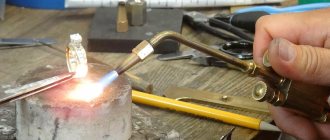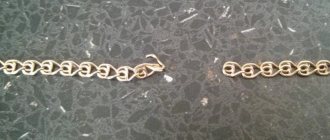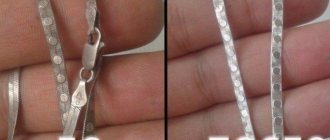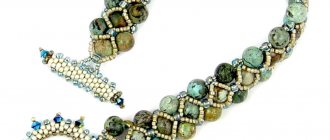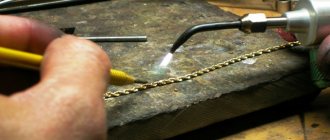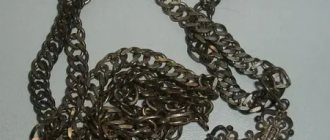Beautiful jewelry can make even the simplest look bright and interesting. Therefore, it is not surprising that many modern people quite actively use gold and silver items, both in everyday life and on holidays. But sometimes you have to look for the answer to the question of how to fix it if the lock on the chain is broken?
- Main types of chain locks
- Locks for jewelry chains and bracelets: which one breaks more often
- How to solder a silver chain: restoring jewelry at home
Is it possible to repair a chain lock yourself, or only in a workshop?
The locks have something on two chains.
They open randomly, the chain falls off, and so on.
Is it possible to repair it myself, or should I take the chains to a jewelry workshop?
There are quite a few types of those same locks on jewelry.
Not every lock can be repaired even in a workshop; in case of serious damage, the lock is simply replaced with a new one.
By the way, the locks on expensive gold chains are hand-made products, that is, not stamped.
If you have a carabiner lock and the damage is not serious, for example this carabiner ring has become bent,
You just need to slightly bend the ring on the carabiner, I usually do this with the handle of a small screwdriver, the handle is wooden.
Try it several times, but do not hit the ring too hard, and then check whether the chain does not jump out of the “tongue”.
If the “tongue” itself does not work, then the reason is a failed spring inside the lock, that is, the spring mechanism needs to be replaced.
This is not done at home; even in workshops they often suggest replacing the carabiner rather than the spring mechanism, especially if the breakdown of this mechanism is serious.
It is possible to produce an individual lock for a specific product.
If the lock ring simply bursts, then laser soldering is needed, that is, the conditions of a jewelry workshop.
Source
Solder joint strength
Soldering allows you to join dissimilar materials. This is the main advantage of the method. But it is important to evaluate the strength of the solder joint, which is an indicator of the quality of work. This is affected by the size of the gap. At low values, the effect of capillary flow is best manifested, that is, the metal of the product dissolves in the solder. This effect increases the strength of the connection by 30-60%.
During work, we must not forget about safety measures. This applies to wearing gloves and a respirator. We must not forget about high temperatures, which can cause a fire.
How to repair or solder a gold or silver chain at home
If worn continuously, hollow or defective, gold and silver chains may break or become deformed. And problems arising in the locking mechanism can lead to loss of the product. How to repair a gold or silver chain at home and what is needed for this? Is it possible to repair a broken chain so that the break point is invisible?
How to solder a chain at home
Repairing a silver chain with your own hands is a filigree and responsible job. It is necessary to have equipment, a set of reagents and, most importantly, skills to work with them. Otherwise, you can damage the product, and instead of restoring it, disfigure it. If the required equipment and reagents are not available and this type of work is new, it is better to abandon the intention of soldering a silver chain at home, and leave this work to a specialist from a jewelry workshop. The same applies to repairing a gold chain.
Basic concepts and definitions
Before you begin repair work on silver or gold, it is important to have a set of necessary materials:
- Solder is a special metal alloy that has a melting point lower than pure metal.
- Flux is a mixture or single substance of an organic or inorganic nature that promotes uniform distribution of solder over the surface and prevents oxidation of the metal when heated.
- An acid solution (not to be confused with acid flux) brightens the metal after soldering.
How to solder a silver chain
Depending on the standard of the silver jewelry, the brand of solder is selected, which is produced in the form of rods, pieces, etc. An equally important characteristic of the auxiliary alloy is its fluidity and hardness.
Silver solder consists of silver, zinc and copper, and may include tin. The higher the silver content in the alloy, the stronger the soldering will be. The melting point of solder ranges from 640 to 780 °C, while the melting point of pure silver is 961 °C.
Soldering a silver chain at home involves several stages.
- Using any fireproof material (brick, asbestos), securely fasten the parts of the product.
- Treat the joints with flux and put solder between them.
- Carefully heat the metal evenly until a soldering seam is formed (try to solder the silver chain so that the seam is strong and at the same time invisible).
- Cool the product, remove flux and solder, then polish.
- To lighten the soldering area, treat it with an acidic solution, such as nitric acid.
It is possible to solder a silver chain at home with a soldering iron yourself, using special solder combined with flux.
Is it possible to solder a gold chain?
At home, it is possible to solder a gold chain in the same way as described above, using gold solder. It contains gold, silver, copper, zinc and in some alloys cadmium. The melting point of solder ranges from 710 to 850 °C, while that of pure gold is 1063 °C.
It is important to understand that repairing a gold chain by a non-specialist, even with the necessary materials, is quite difficult. Therefore, the best way out of the situation is to use the services of jewelry repair specialists.
What gold repair services do jewelers provide?
The delicate and complex specifics of working with stone and gold require special equipment and the experience of the craftsman. The main condition for gold repair is a high-quality update of the product without its radical transformation. The most common service in the list of types of gold jewelry repairs is soldering.
Causes of chain wear
But with the help of soldering and welding, not only chains are repaired. This is generally one of the main types of repair work in jewelry. For example, soldering eliminates such defects.
- Worn lugs and cross rings on pendants and drop earrings. But here soldering is possible with minor damage, otherwise it is better to replace these parts.
- Worn pins in gold glider bracelets or necklaces. A pin is a part in a structure that serves to connect two parts (gliders) of a gold product. In such cases, experts recommend replacing all the pins with new ones. This is due to the characteristics of bracelets or necklaces, which consist of glider links connected in different ways. The most difficult thing is to replace the pins hidden inside; they (or their remains) have to be drilled out when repairing a gold item.
- Cracks that usually appear due to manufacturing defects (possible problems in casting or poor quality assembly). This defect usually appears when the metal is fatigued or under additional loads.
Repairing gold jewelry with inclusions or coatings requires even more professionalism and experience. After all, inserts, that is, any cut stone or plate made of amber, turquoise, pearls, as well as enamel, cannot withstand high temperatures, as well as galvanizing or oxidation. In such cases, the inserts are isolated, secured, and if this is not possible, then replaced.
The coatings additionally have to be restored, and sometimes the enamels have to be reapplied. In these cases, it is certainly better to use high-precision laser welding or contact soldering rather than an open flame of a torch.
Repair of enamel jewelry
This is one of the oldest techniques in jewelry making. The first enamel accessories - rings found in burials in Cyprus - are dated by archaeologists to the 12th century BC. And, probably, one of the most beautiful techniques, so it is not surprising that recently more and more enamel items have begun to appear. But repairing them is very difficult. In addition to normal wear and tear and chips with cracks, abrasion of the enamel is added. Jewelers have to tinker with its restoration.
The lock on the chain is broken: how to fix it
There are mainly 3 types of locks used in jewelry:
- carabiner, in which the pin or spring may break;
- springel - practically cannot be repaired, only replaced with a new one;
- box - the tongue or insurance breaks.
It is easy to repair a lock on a chain with your own hands if its individual parts are not broken, but somewhat deformed, for example, in the case of a box lock. You just need to press a little and return them to their previous position. You can repair the carabiner by replacing the pin or spring (if available).
What to do if the chain is stretched
Since silver and gold are soft metals, the weave can stretch out if not handled carefully. First of all, this applies to products made from low-quality alloys or with complex filigree weave. Under severe external influence, a stretched silver chain or gold weave becomes irreversibly deformed.
Heavy gold chains in the Sunlight catalog
If a gold chain of simple weaving has stretched, you can independently remove some of the “extra” links to the previous length. If the weaving is complex and multifaceted, then regardless of the material, it is better to seek the help of a specialist.
Why does the chain around your neck break?
If you believe superstitions, this sign has a dual explanation.
- If the chain with a cross breaks, God gives you the right to choose your own path.
- Another explanation says that people with negative energy have appeared in the environment, who wish evil, cause damage, and the sacred symbol neutralizes this effect.
- If the chain with the cross breaks, but you managed to catch the cross, health problems lie ahead.
If we discard all signs and superstitions, the breaking of the chain is explained either by careless handling or poor quality of the product.
“Close my love around your neck, I live to adorn you - you are my jewel,” said Grace Livingston-Hill (American writer). Careful and careful handling of jewelry will prolong the joy of “communication” with it for many years.
Source
Repair and replacement of locks on chains, earrings and bracelets
Beautiful jewelry can make even the simplest look bright and interesting. Therefore, it is not surprising that many modern people quite actively use gold and silver items, both in everyday life and on holidays. But sometimes you have to look for the answer to the question of how to fix it if the lock on the chain is broken?
- Main types of chain locks
- Locks for jewelry chains and bracelets: which one breaks more often
- How to solder a silver chain: restoring jewelry at home
Practical advice
Almost every day people come to various jewelry stores with the question of where gold chains are repaired, as well as where they can buy clasps and links for various products. This fact indicates that the jewelry is quite fragile and can break if handled carelessly. Nowadays, girls very often wear thin jewelry, which can break if it gets caught on some object.
If your gold, silver or other metal chain breaks, take it to a workshop. Modern jewelry makers use the latest technology to repair jewelry. This allows you to make the product the same as it was before it was torn.
Why do locks on chains and earrings break?
Not everyone knows that repairing or replacing a lock on a chain is a quick and not very difficult operation if a master gets to work. Professional repair of locks on jewelry requires special equipment, optics, a laser welding machine, and consumables. If you do not want to part with your favorite jewelry, the jewelers of the ArtBazar workshop in the center of Rostov-on-Don will quickly repair or replace the lock on a chain, bracelet or earrings in your presence. The lock on a chain, earrings or bracelet, regardless of its type and complexity of manufacture, must function correctly so that there is no risk of losing the jewelry. A working lock on a chain fastens and unfastens smoothly, effortlessly, and closes tightly. Unfortunately, due to frequent use or careless handling, the chain lock mechanism wears out, begins to jam, or does not close completely. If you do not immediately send your jewelry for repair, it may break completely or even slip off unnoticed and get lost. If you notice that the lock on the chain does not work the first time, jams, or does not work as well as before, it is better to immediately bring the jewelry to a jewelry repair shop and find out whether the lock needs to be repaired, replaced, or just have the jewelry professionally cleaned.
Causes
First of all, let's consider the possibility that the cause of the breakdown could be a defect. In order to confirm or refute this version, it is necessary to conduct an examination. If the presence of a manufacturing defect is confirmed, the manufacturer can either reimburse the cost of repairs with an examination, or return the money for the product. But if it turns out that you yourself are to blame for the fact that the jewelry is torn, then you will have to pay for the repair yourself.
It is for this reason that it is better to immediately think about the necessary repair of the jewelry. The more complex the repair, the more expensive it will cost. Try repairing your jewelry yourself. If the fastener malfunctions, you can buy it separately, even from a different metal, as long as the color matches, and install it yourself, as shown in the video.
Most breakdowns are best fixed in a professional workshop. The cost of the work depends on the reason for which the chain broke. It is quite common for a product to break while trying to untangle it. If your jewelry is not completely new, then its links may become loose from prolonged use. In such a situation, the worn links will be replaced with new ones. To determine whether a silver chain needs repairs, carefully examine all of its links through a magnifying glass.
Another common reason why chains often break is because they are light in weight. Most often, such products are made from tubes. Outwardly, they are very similar to jewelry made from wire, but they weigh much less and the price is much lower. But by paying less for such a product, you will end up paying a lot of money over time for constant repairs of such jewelry.
Sometimes products are torn due to the fact that rather heavy pendants are hung on them. It is necessary to take into account the ratio of the weight of the pendant and the thickness of the product on which you are going to hang it. But remember that whatever the reason for the chain breakage, a professional technician will definitely carry out such repairs that you will not notice local adhesions, as in the photo.
In order to understand whether the product is hollow, hold it in your hand. It will immediately become clear to you if there are any discrepancies between the weight and size of the jewelry. Such chains most often break even from the slightest mechanical impact. Heavy crosses or pendants should not be hung on them, as this can cause them to wear out quickly.
Types of jewelry lock failures
Locks on chains, earrings and bracelets come in different types of fastening. Different types of locks on jewelry have different types of breakdowns.
The following types of locks are usually found on gold and silver jewelry:
- carabiner, in the form of a loop with a tongue, they often have to change the pin or spring;
- springel, in the form of a thin hollow ring with a bent rod, they are more often replaced than repaired;
- lock-boxes, the tongue and insurance break in them.
The most popular repairs are locks on chains and bracelets. These jewelry are worn every day and are subject to stress and stretching. Even such a reliable type of chain lock as a carabiner will eventually break.
Box locks on bracelets have additional insurance, but such locks also have to be repaired by soldering or replaced with new ones. Earring locks break less often. Reliable earring locks with screw locks, spring locks and English locks are still not immune to breakage. Masters of the ArtBazar jewelry repair workshop in Rostov repair and replace locks on gold and silver chains, bracelets, earrings of any type and any complexity.
Ultrasonic cleaning: high technology
This procedure allows you to clean the item not only from visible dirt, but also from microbes, which feel good having chosen such an unconventional place to live as jewelry. Firstly, cleaning returns the lost shine and charm, and secondly, gold becomes truly safe in a medical sense.
Sometimes cleaning can extend the life of your jewelry. Locks on chains, bracelets, and earrings often break. If we are talking about a carabiner lock, then it has a spring made of ordinary metal. When a person washes and sweats, the metal rusts and breaks down. As a result, the lock needs to be changed. But cleansing may well delay the problem or even completely eliminate it.
Ultrasonic cleaning technology is as follows: in a bath filled with a special liquid, all possible contaminants are destroyed (as jewelers say, “knocked out”) using sound vibration. An absolute plus of the procedure: it tests the strength of stones. If the stone does not fit well, it will be knocked out. This means that it needs to be secured and prevented from being lost.
The peculiarity of this cleaning is that it cannot be used for some products.
| Varieties | Negative consequences |
| With emeralds. | These are fragile stones and sound can break them. |
| With glued elements and inserts: pearls, mother-of-pearl, rhinestones. | In this case, the sound will “knock” them out of place and destroy them. |
Hook lock
Jewelry with this clasp option also has a teardrop shape. Products with such fastening are easy to put on and take off. As an advantage, it is worth noting the huge number of variations in the implementation of such a lock. It comes in any shape, made of plastic, wood or metal. The negative point is that it is unreliable and the decoration is easy to lose.
How to make a clasp on a bracelet with a hook? To do this, each part of the lock has holes for gluing a cord, as well as small loops to which a chain or textile, or a clamping part, clings. When connecting, you can add a cord with decorative elements - large beads, key chains or plant figurines. The ends of the bracelet are inserted into the hole in the lock and then clamped using a special device.
The Importance of Silver in Ancient Times and Today
In ancient times, silver was considered a sacred metal. It was used to create amulets that protected people from dark forces and evil spirits. Gradually, this metal began to gain popularity as jewelry. In addition to making rings, earrings, pendants and chains, people made silverware.
Silver was often called lunar material and could only be worn by members of the nobility or people associated with religious teachings. This material was not available to ordinary peasants. Gradually money (coins) began to be made from silver. Now this metal is used for making jewelry, as well as in electrical engineering (silver plating, contacts).
Read also: How do mechanical watches work?
Why you shouldn’t repair chain locks yourself
Sometimes people think that sending jewelry for repairs is expensive and time-consuming. Someone tries to repair a lock on a chain with their own hands or stops wearing jewelry. On the Internet you can find instructions on how to repair a lock on a chain or earrings yourself. In fact, it is better not to repair locks on expensive jewelry yourself. As a result of rough manipulations, you can break the jewelry, reduce the weight of the valuable metal in the product, reduce its price, and make the repair site visible to the eye. All this is unacceptable in relation to jewelry. Moreover, repairing locks on chains, bracelets and earrings in the ArtBazar jewelry workshop in Rostov is quite inexpensive and is done in the shortest possible time.
Protective covering
At the request of the owner, the accessory can be strengthened by applying a special coating. With the help of special techniques, not only the appearance is improved and the desired effects of jewelry (shine, color, texture) are enhanced, but also the service life is extended - “wear”. Among these techniques is, for example, rhodium plating. Rhodium is a metal of high hardness and, accordingly, wears out more slowly than gold. Rhodium plating can be white, black, or colored.
Many people believe that rhodium plating or plating, for example, with ruthenium, will keep jewelry in the “like new” stage for a very long time, but jewelers are skeptical about this thesis. Yes, men's chains are especially often coated with ruthenium, since the stronger sex tests everything for strength. But dishonest jewelers, seeking to optimize the process at any cost, try to thin the layer of rhodium or other material as much as possible, turning it into something purely symbolic.
The visual effect of such coatings is obvious, especially in cases where the stone requires a specific background. It is still worth wearing jewelry carefully, without subjecting it to unusual overloads.
Clasps (clasps) for jewelry
1) Size of jewelry: small clasps will look neat in miniature jewelry; large clasps are better suited for massive jewelry.
2) Weight of jewelry: for heavy jewelry, for example, from large stone or porcelain beads, it is better to select the most reliable fasteners, such as carabiners, sliders, toggles, and some types of hooks.
3) Number of rows in the decoration: for multi-row or wide decorations, you should choose clasps with several loops or use adapter connectors.
4) Type of decoration: almost all types of clasps are suitable for neck jewelry, but for bracelets it is better to use more reliable clasps that will not unfasten on their own when your hand rubs against clothes or other objects. In addition, for bracelets it is better to use clasps that you can unfasten or fasten yourself while putting on the bracelet. Despite such limitations, you can choose a suitable clasp for a bracelet in almost any type of clasp - the main thing is to take into account all other factors. In our opinion, the most convenient clasps for bracelets are toggles, sliders, strong magnetic clasps, carabiners (if you get the hang of fastening them yourself).
5) Ease of use: when assembling jewelry, you must take into account the fact who will wear this jewelry. For people with low vision and impaired fine motor skills (for example, older people), it is better to use large, easy-to-fasten/unfasten clasps. For small children, it is better, on the contrary, to use clasps that are difficult to unfasten on their own - this reduces the likelihood that the decoration will be lost.
6) Does the length of the jewelry need to be adjusted: if the jewelry is made for sale, it is better to install a clasp that allows you to change the length of the jewelry, for example, by using an extension chain. Such fasteners include: carabiners, rings, hooks, snap fasteners. If the jewelry is created for a specific person, you can make the jewelry of a fixed size and use any type of clasp. Note that all types of fasteners can be used for transformable jewelry that has variable length. Even if the clasp does not have the possibility of extension (it consists of two parts that can only close on each other), you can make a decoration with several such clasps. That is, the decoration will consist of several parts, each of which can be fastened either on its own or attached to another part of the decoration. In this way, you can make beads/necklaces that can change length, or a bracelet and necklace that can be worn as a set, or can be clasped together and worn as long beads, as shown in the photo below:
7) Decoration design: of course, when choosing a clasp, you should definitely take into account the design of the decoration. The clasp should not stand out from the overall style of the decoration or draw attention to itself (unless, of course, it is the central element of the decoration).
In some cases, you can do without a fastener. For example, when assembling jewelry using an elastic band, memory wire, or when creating long beads worn over the head or tied in a knot. On bracelets woven from cords, the clasp can be replaced with a slip knot or a button clasp. Wide textile or leather bracelets can be laced. Examples of jewelry created without the use of clasps are presented below:
Where to repair a lock on a gold or silver chain in Rostov
Jewelers from the ArtBazar workshop perform quality and professional repairs and replacement of locks on jewelry, clean and adjust locks. At the same time, you receive free advice on caring for your jewelry so that your chains and earrings do not break for as long as possible. Most often we have to carry out the following types of repairs on locks of chains, earrings and bracelets:
- solder chain links when broken by placing one end on the other;
- solder a torn or frayed ear by adding metal or narrowing the hole;
- make a new ear instead of a broken one;
- unsolder and insert a new spring instead of a broken one into the lock of the product.
In some cases, we use laser welding to restore parts of jewelry locks and to secure new clasps. In this case, the seam remains invisible and the metal is not damaged. If the lock on a chain, earrings or bracelet breaks, bring the jewelry to the ArtBazar jewelry workshop in the city of Rostov. We will quickly, efficiently and inexpensively repair or replace jewelry locks of any complexity.
Let's sum it up
Many men and women wear chains these days. This is a very elegant and versatile piece of jewelry that will suit any style of clothing. But quite often, owners of such products are faced with the fact that the chain is very easy to break. The main thing is not to get upset and remember that modern craftsmen, using the latest technologies, are able to repair almost any piece of jewelry.
Gold jewelry delights us with its grace, beauty, and brilliance. And if your favorite thing breaks, what should you do? Of course, fix it. Gold repair in jewelry workshops is a service that is found in any city, almost more often than beauty salons or bank branches.
Pin lock
Having heard such a name, it is difficult to imagine how the product is fixed. In fact, the lock looks almost the same as magnetic rectangles. The only difference is that on one side there is a small pin with a thread, and on the other there is an inlet hole.
At first, the lock closes and opens with effort, but after some use the process becomes noticeably easier. How to make a clasp on a pin bracelet? It is attached in the now familiar way: by gluing it to the base of the product. It is worth noting that this type of lock is most suitable for men's bracelets or those made in a classic style.
There is an even simpler version of the pin. A ring is attached to one side of the jewelry, and a horizontal pin is attached to the other. The lock is fastened by threading the second part into the hole.
How to improve zipper performance
There are several simple ways to treat surfaces using lubrication:
Waxing
You can rub the cloves on both sides with a regular paraffin candle or beeswax. The zipper can be closed or open.
The paraffin will fill the voids between the teeth. The runner will slide more freely.
Lubrication with pencil lead
It is recommended to follow the color scheme and carefully handle the zipper teeth with a stylus. The pencil should be soft, a 3M or 4M brand intended for drawing is best.
Lubricating the zipper with wax or pencil lead makes it easier to slide, protects from external influences and increases the life of the slider. However, graphite can penetrate clothing and contaminate it.
How to change a zipper slider
If, after an unsuccessful repair attempt, a breakdown occurs, you will need to look for a new part that is suitable in size and design, and then replace it with the broken one.
Lock selection criteria
First you need to determine the characteristics and type of the faulty slider. Its number is indicated on the reverse side. It can simply be measured with a regular ruler.
The classification of runners is discussed in detail above. However, when visiting the store, it is necessary to have a sample of the broken part, as well as a clear understanding of the type of fastener.
Slider replacement technology
After choosing and purchasing a lock, they begin to replace it. To do the job you need a simple tool:
- unzip the zipper all the way;
- remove the limiter on one side;
- fasten the zipper and remove the slider from the side where there are no limiters;
- insert a new slider;
- Lightly compress the removed limiter with pliers and install it in its original place;
- tuck the ends of the tape.
Features of replacing the slider on different types of zippers
Each type of fastener design has its own specifics.
Metal zippers
You should use side cutters and a screwdriver to remove the upper limiter on the right side and try to replace the slider. Thickening of the tape may interfere with this work.
In this situation, the tips of the scissors are used to cut the tissue. A slider is carefully inserted through the incision with gentle rocking. The place of the cut on the braid is reinforced with two stitches of thread or a limiter is installed on it.
Tractor zippers
The slider is usually easily inserted into such a fastener through the stoppers; it is not necessary to remove them.
If the limiter interferes, you will have to remove it, and after replacing the lock, install a metal or homemade analogue. All actions are performed with the clasp unfastened.
